Chair's Message
 As 2016 draws to a close, we at the Board have been looking back to see what the trends and issues have been this year. Probably the most significant trend to note is that the Board has received double the normal number of public complaints and concerns with forest management and practices this year. (Public concerns are the first step towards a complaint investigation.) We will see if this trend continues into 2017. The Forest Range and Practices Act (FRPA) was implemented nearly 15 years ago as lean, innovative, results-based legislation designed to maintain and enhance, where possible, the standard of forest management and practices while reducing regulatory costs and time to access forest resource–the red-tape. Many of the goals of FRPA have been realized but, like any regulatory system, implementation is ongoing and there is always room for improvement. BC is one of the only jurisdictions in the world to have an independent watchdog–the Board–to provide oversight and identify and recommend improvements to the regulatory system. Over the past ten years, the Board has suggested legislative and regulatory improvements to FRPA and the policies that support it. Some have been implemented, but many have not. These suggestions have been based upon the Board’s findings from its audit, complaint, appeal and special report programs. They are meant to strengthen the regulatory regime, achieve continuous improvement, ensure stewardship of all forest and range values, and demonstrate BC’s continued commitment as leaders in forest management. Like a car or an airplane, legislation requires regular maintenance or it will break down. In the coming year, as a way to encourage the regulatory improvement discussion,the Board will consider issuing a report on the status of responses to legislative and regulatory recommendations it has made in recent years. These recommendations are a result of Board experiences on the ground and identify systemic issues with FRPA and the framework that supports it–objectives, plans & practices, compliance & enforcement, effectiveness monitoring and professional reliance.
As 2016 draws to a close, we at the Board have been looking back to see what the trends and issues have been this year. Probably the most significant trend to note is that the Board has received double the normal number of public complaints and concerns with forest management and practices this year. (Public concerns are the first step towards a complaint investigation.) We will see if this trend continues into 2017. The Forest Range and Practices Act (FRPA) was implemented nearly 15 years ago as lean, innovative, results-based legislation designed to maintain and enhance, where possible, the standard of forest management and practices while reducing regulatory costs and time to access forest resource–the red-tape. Many of the goals of FRPA have been realized but, like any regulatory system, implementation is ongoing and there is always room for improvement. BC is one of the only jurisdictions in the world to have an independent watchdog–the Board–to provide oversight and identify and recommend improvements to the regulatory system. Over the past ten years, the Board has suggested legislative and regulatory improvements to FRPA and the policies that support it. Some have been implemented, but many have not. These suggestions have been based upon the Board’s findings from its audit, complaint, appeal and special report programs. They are meant to strengthen the regulatory regime, achieve continuous improvement, ensure stewardship of all forest and range values, and demonstrate BC’s continued commitment as leaders in forest management. Like a car or an airplane, legislation requires regular maintenance or it will break down. In the coming year, as a way to encourage the regulatory improvement discussion,the Board will consider issuing a report on the status of responses to legislative and regulatory recommendations it has made in recent years. These recommendations are a result of Board experiences on the ground and identify systemic issues with FRPA and the framework that supports it–objectives, plans & practices, compliance & enforcement, effectiveness monitoring and professional reliance.
On behalf of the Board members and the staff, I wish you a Merry Christmas, Nollaig Shona, Happy Hanukah, and a happy, healthy and successful 2017!
Stewardship
In our Stewardship Bulletin (2015), the Board said it would point out examples of stewardship, evaluated against the principles set out in the bulletin, in order to foster discussion and to promote improved performance from licensees, managers, practitioners and users of BC’s forests, rangelands and resources. A number of examples of practices that reflect some of the stewardship principles were seen by Board staff in 2016.
Notable Practices in an Audit
In February, we published an audit that highlighted two notable practices. The auditee was lauded for its electronic bridge registry and terrain stability risk assessment strategy, neither of which the Board has seen anywhere else. They kept a very detailed bridge ledger, recording and digitally linking construction, inspection and maintenance documents in one central, easy to follow location. They also developed a terrain risk management strategy that informs and guides forest road and harvesting activities. It was developed with terrain and hydrological expert assistance, and has been in use by the company since 2013.
CMTs and Visual Resources
This licensee had to put a road and dry land sort in one location, as there was no other practical solution. There were some culturally modified trees (CMTs) on site and First Nations elders wanted easy access to the CMTs for educational purposes. There was also a historic trail that went from a launch/camp site on one side of the sort area to a fresh water source on the other side. The licensee constructed a trail access point so that elders could get to the trail from the road, and carefully moved the CMTs to an area just off the new road location where they can be viewed. In addition, the sort is located in an area used by kayakers and visible up the inlet from a provincial park. Dry land sorts can be ugly. They are usually on the ocean front and replace the natural treed shoreline with rocky fill, woody debris and logs. The licensee planned the sort to minimize the visual impact. It has one narrow slot down to the beach for loading barges with logs and the working/sorting area is screened with standing timber.
Forest Health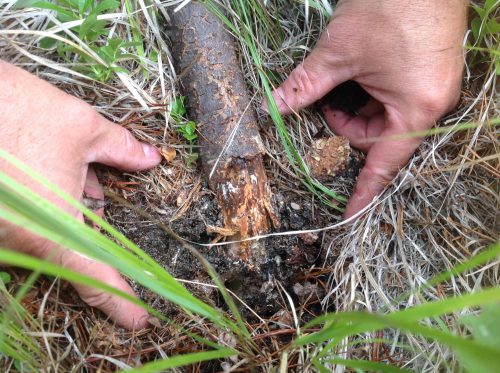
This licensee established a mixed species plantation, and as a result, an outbreak of Warren root collar weevil on lodgepole pine was not serious. The stand still meets free-growing criteria based on the number of healthy Douglas-fir, white spruce and western larch that were unaffected by this pest. A pure pine stand would have been devastated. The licensee is aggressively managing Douglas fir bark beetle populations. One of the tools used is funnel traps that capture beetles before they can attack living trees. The traps are baited with pheromones to attract the beetles and use an insecticide strip at the bottom to catch the beetles and prevent escape.
Mapping and Protecting Cultural Resources
This licensee spent a considerable amount of time locating and mapping cultural resources in cutblocks in order to meet the requirements of a land use objectives order (LUO). Culturally significant plant species identified in the LUO, in part, include individual stems and patches of yew and crabapple, CMTs and cedar. The licensee planned retention for species representation and retention of CMTs and monumental trees. It also did a thorough job in identifying and protecting these species while harvesting. Some of these examples, and others, will be featured in our 2017 calendar, which will be available for download from the Board website in late December.
Audit Season Update
The Board carried out 10 audits over the 2016 field season, with the last one wrapping up in late October. Audits looked at a variety of operators, from major forest companies to community forests to small First Nations’ licences, and included five range tenures. Auditors crossed the province from Golden to Squamish and up to Haida Gwaii and Mackenzie in the north. Five of the audit reports have been completed and published and are available on the Board website. The remaining audits are in progress and will be published in the first quarter of 2017. So far, the 2016 audits that have been published are pretty positive. The number of reportable issues is lower than for the audits carried out in 2015. However, we continue to see issues with fire hazard assessments not being completed by licensees, despite our efforts to raise awareness of these legal requirements.
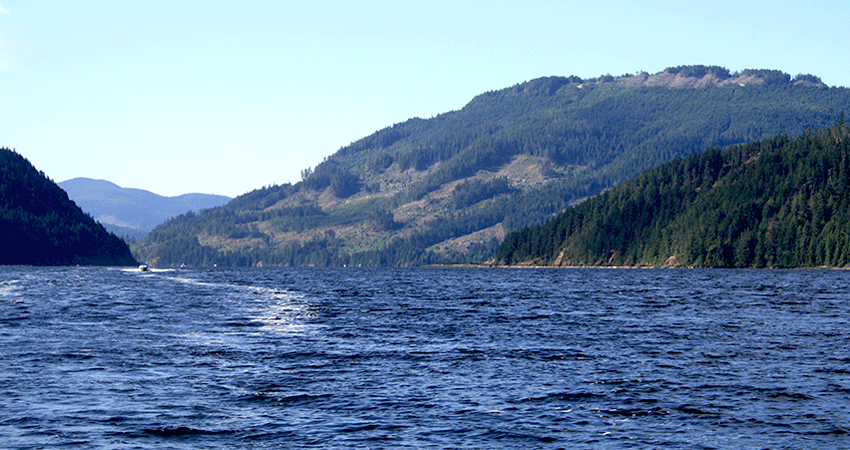
Forest Appeals Commission Decision on Visual Management
Earlier this year, the Board participated in a lengthy Forest Appeals Commission (FAC) hearing on visual quality objectives on the West Coast at Stuart Island. The FAC released its decision in July 2016: it addresses many of the challenges that foresters face in meeting visual quality objectives (VQOs), and provides a thoughtful approach to assessing compliance with VQOs. Some of these challenges include:
- Identification of significant public viewpoints
- The use of photographs, simulations and visual impact assessments
- Understanding the terminology used in forest practices regulations
The Board strives to emphasize solutions, and for this reason, its most recent report on the Alberni Inlet includes recommendations to government and the Association of BC Forest Professionals (ABCFP), calling for a review and update of guidance and policy documents to ensure consistency of approach and use of best practices in the management of visual resources. We will continue to monitor the actions taken by government and the profession over the coming year, and publicly report on progress at the appropriate time.
2016 Communications with the Public
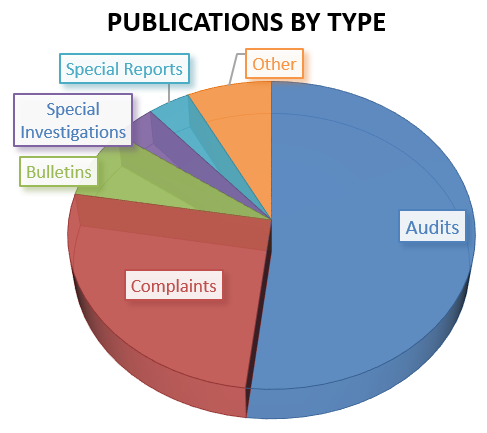
27 Reports published
- 14 audits
- 7 complaint investigations
- 2 bulletins
- 1 special investigation
- 1 special report
- 1 annual report
- 1 guidance document describing the Board’s range audit process
28 News releases issued
- In addition, four articles featuring Board reports were published in stakeholder newsletters and magazines.
Media stories
- 73 media stories about the Board and its reports in newspapers and online
Media interviews
- Board Chair Tim Ryan gave 19 interviews to media about various Board reports
Speaking engagements
- 23 speaking engagements featuring Board members and staff
Recent Meetings and Presentations
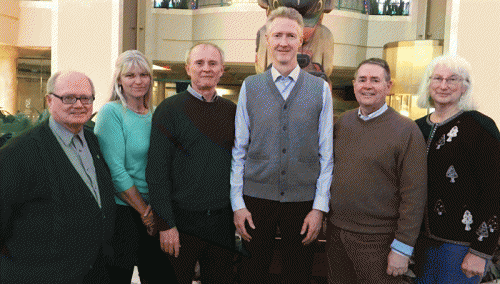
Board Members (from left to right): Dr. William McGill, Marlene Machmer, Ralph Archibald, Tim Ryan, Ken Higginbotham, and Norma Wilson.
On September 30th, Audits and Investigations Manager Daryl Spencer spoke at the Woodlot Product Development Council/ Federation of BC Woodlot Associations annual general meeting in Prince George. Daryl spoke about results of recent woodlot audits and the ongoing special investigation of woodlot management in the Kootenay Lake TSA that is looking more deeply into some of the issues found in the audits. Audits Director Chris Mosher and Daryl also met with the executive of the Woodlot Association to discuss current issues and concerns with woodlot management under FRPA. In October, Audits and Investigations Manager Garth Lord and contractor Del Ferguson spoke at the Association of Professional Engineers and Geoscientists (APEGBC) annual general meeting in Victoria on the topic of forestry roads in steep terrain. Garth and Del presented a slideshow of some of the construction practices in steep terrain that the Board has observed in recent years. They explained the objectives and approach of the ongoing special investigation of road construction that the Board began in late 2015 as a result of the issues encountered in the last few years. Garth and Del will be giving the same presentation at the ABCFP AGM in Prince George in February 2017. In November, Board Chair Tim Ryan and Investigations Director Ken Zielke both spoke with Masters students in the Forestry program at UBC’s Vancouver campus. Board General Counsel Mark Haddock also spoke to students in a Forest Practices and Management class at UNBC in Prince George. In mid-December, the Board held its quarterly meeting in Victoria. Newest member Ken Higginbotham attended and Board members had an opportunity to say farewell to Bill Dumont and Angelina Nyce. Staff updated the Board on the progress of ongoing audits and investigations and strategic issues arising in the various files. The Board then considered potential topics for future special investigations and special reports as part of its’ strategic priority planning process.
Responses to Board Recommendations
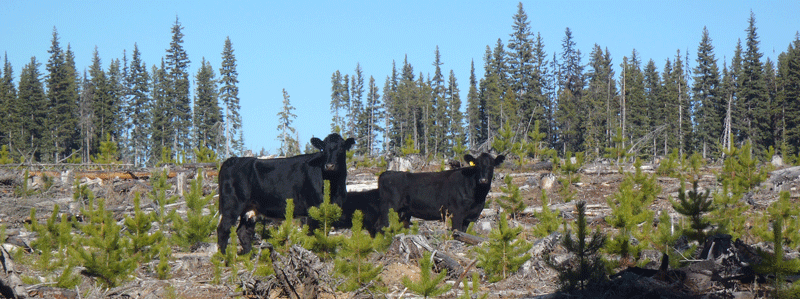
Harvesting Impacts on Natural Range Barriers near Sharpe Lake
– Complaint Investigation FPB/IRC/200
This investigation was published in March 2016 and found that West Fraser Mills had impacted a natural range barrier in its harvesting operations near Sharpe Lake. The Board recommended that the Ministry of Forests, Lands and Natural Resource Operations should monitor cattle movement to determine if the natural range barrier in question had in fact been breached by nearby timber harvesting, and if cattle were getting through. In July 2016, the ministry advised the Board that West Fraser and the complainant had reached an agreement whereby West Fraser would install a fence to prevent cattle from moving through the area. This agreement addressed the Board’s recommendation and there is no need for the monitoring to take place. The file was closed in July.
Forest Stewardship Plans
– Special Investigation Report FPB/SIR/44
This 2015 report made recommendations to government and the ABCFP aimed at improving the content of forest stewardship plans (FSPs). Both organizations responded positively to the Board’s recommendations and have been implementing measures to improve FSPs. Since our last update in the Summer 2016 issue of this newsletter, government carried out an ambitious province-wide FSP training program for licensees and government staff and the ABCFP actively participated. The ABCFP has also incorporated modules in its new member registration process regarding FSPs and making measurable or verifiable results and strategies. Earlier this year, the chief forester issued an expectations letter to all licensees and government district managers issued expectations letters to their licensees detailing district level expectations, including that all FSPs be rewritten upon expiry, rather than extended. The chief forester recently issued a second letter to licensees with comments on progress and expectations. This will help to reinforce the expectations relayed in the first letter and subsequent DM letters. These are positive steps that go a long way towards implementing the Board’s recommendations. However, one significant area where the Board is still hoping to see more improvement is enabling public comment on cutblocks and roads. We will continue to monitor progress on the improvement of FSPs.
District Managers Authority
– Special Report FPB/SR/52
This special report identified issues with district managers inability to stop issuance of cutting or road permits that meet the basic content requirements of FRPA, even if they have concerns that there is a significant risk to public health & safety, or to the environment, or that non-compliance is likely to result if the operations proceed. The Board recommended a change to regulations to provide district manager’s with more authority in limited circumstances. The Ministry responded in April 2016 that it was looking into the issue with district managers and legal counsel, and would identify any opportunities to strengthen legislation as part of its annual FRPA continuous improvement strategy. The Board requested that it be advised of the outcome of this work, but has received no further communication on the matter as of December 2016.
New Complaints from the Public
2016 saw a measurable increase in the number of public complaints received. The last few years have averaged only 4-6 complaints per year, but in 2016 the Board received over a dozen new complaints from members of the public.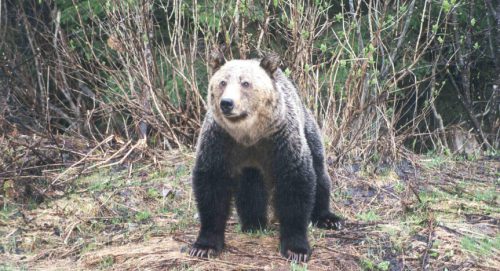 Topics complained about are broad, from water protection, to wildlife and biodiversity management to visual impacts of logging. Complaints came from all across the province, although the Okanagan region had more complaints than the others. And the types of forestry operators involved in the complaints were varied, with no one type of company or operator standing out. The complaints are keeping Board staff very busy, as these are in addition to the many public concerns that staff also work to help resolve prior to formal complaint investigation. Those concerns are also up this year. As of December, the Board has 15 concerns and 12 complaint investigations in progress.
Topics complained about are broad, from water protection, to wildlife and biodiversity management to visual impacts of logging. Complaints came from all across the province, although the Okanagan region had more complaints than the others. And the types of forestry operators involved in the complaints were varied, with no one type of company or operator standing out. The complaints are keeping Board staff very busy, as these are in addition to the many public concerns that staff also work to help resolve prior to formal complaint investigation. Those concerns are also up this year. As of December, the Board has 15 concerns and 12 complaint investigations in progress.
Special Projects Underway
FREP Review Update
FREP Review Update
Staff are putting the finishing touches on the Board’s review of the Forest and Range Evaluation Program (FREP) at the Ministry of Forests, Lands and Natural Resources (FLNR). Staff have interviewed over 100 people from across the province including ministry staff, forest licensees, other stakeholders and researchers. Staff also convened a science panel of provincially recognized specialists in monitoring natural resources to help guide the review of FREP. The draft report is being readied for a Board panel to review and our intent is to publish the report before March 31, 2017.
Steep Roads Update
The field work for this investigation was completed last fall and the report is being written now. Staff gave a presentation on the project design and purpose at the APEGBC AGM in October, which was very well received. Board staff are also giving a presentation to Western Forest Products planning group in February in Campbell River and will give a presentation at the ABCFP AGM, also in February, in Prince George. We are hopeful the report will be finalized in time to discuss the findings at these upcoming presentations, but if not, it will be published by the end of March. 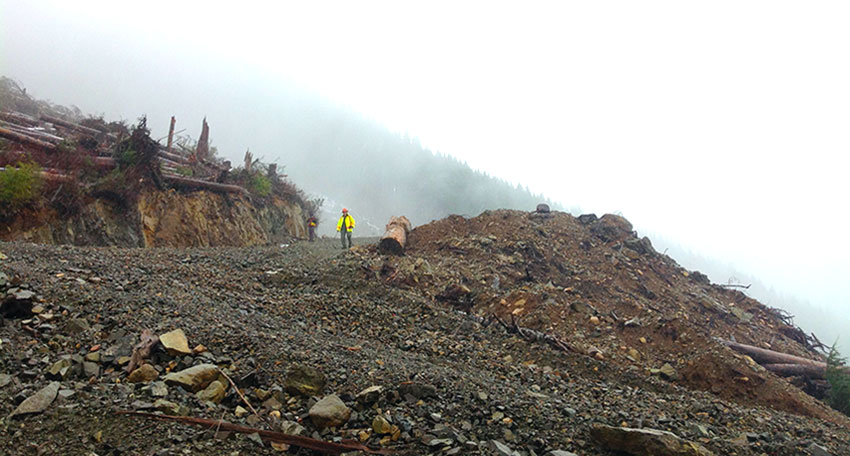
Young Stand Harvesting Update
Staff have been collecting and analyzing data and carrying out interviews with FLNR head office and district staff, licensees and other subject matter experts. Report writing will begin early in the new year and we hope to have the report published by fall 2017.
Woodlot Special Investigation
This investigation is a follow-up to the woodlot audit done in 2015, where auditors found numerous issues on the four woodlots examined. As a result, the Board decided to look deeper into the district’s woodlot program. Staff have been interviewing FLNR woodlot program staff and compliance and enforcement staff, as well as representatives from the Federation of Woodlot Associations of BC. They also examined all 14 woodlots in the district for planning and reporting practices. The plan is to complete and publish this report sometime in spring 2017.
Fish Management Special Report
Staff are midway through writing a special report on how government is managing fish habitats. This report looks at fish habitat management from the perspective of BC legislation and regulations, programs, information management, and compliance and enforcement in the context of activities at the federal and municipal levels. Staff have been gathering information and interviewing fish habitat biologists, hydrologists and others working with fish habitats. This report will inform a field-based special investigation on forestry and range activities in fisheries sensitive watersheds planned for 2017. The special report should be published in the first half of 2017, and the field-based project is expected to conclude in 2018. 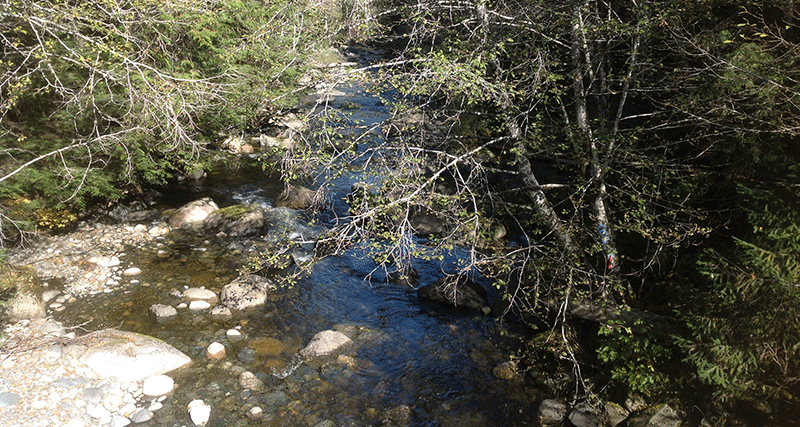
People
Board Member Changes
Board Member Changes
 In November the Board welcomed part-time Board member Ken Higginbotham. Ken is probably best known in BC for his time as Vice-President, Forestry with Canfor Corporation. Ken also served as the Director of Research and Assistant Deputy Minister of Forestry with Alberta Natural Resources, and has taught forestry courses at the University of Alberta and University of North Carolina. Ken also Chairs the BC Forest Safety Council.
In November the Board welcomed part-time Board member Ken Higginbotham. Ken is probably best known in BC for his time as Vice-President, Forestry with Canfor Corporation. Ken also served as the Director of Research and Assistant Deputy Minister of Forestry with Alberta Natural Resources, and has taught forestry courses at the University of Alberta and University of North Carolina. Ken also Chairs the BC Forest Safety Council.
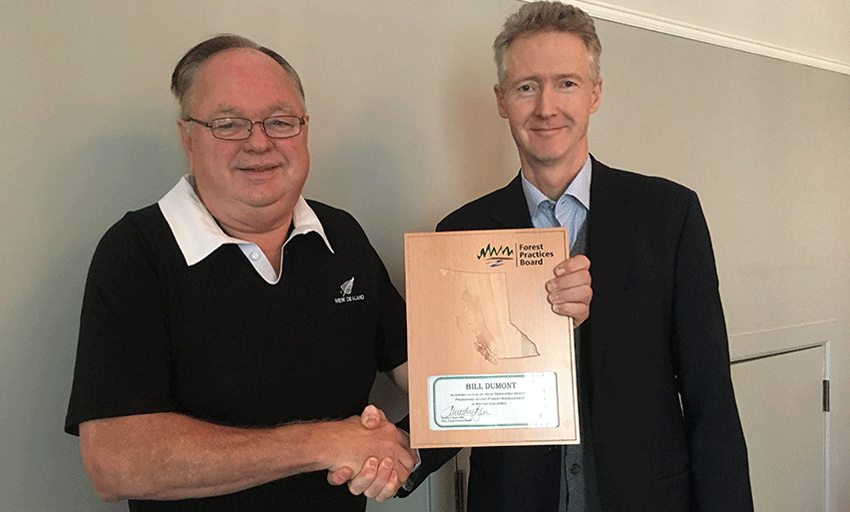
Bill Dumont left the Board at the end of November after completing the maximum of six years as a Board member. Angeline Nyce also completed her term at the end of November. Both Bill and Angeline brought their experience, common sense, and invaluable insight on First Nations interests in forests to the board’s work. Tim Ryan was reappointed to another year as Board Chair and both Marlene Machmer and Norma Wilson were reappointed as part-time Board members. They join continuing members Dr. Bill McGill and Ralph Archibald.
Retirements
Investigations Director Ken Zielke will be retiring at the end of January 2017. We are in the process of recruiting a new Director to take over the complaint investigation and special investigation programs.
Succession Planning
The need for succession planning is becoming a significant issue at the Forest Practices Board. We have an aging workforce and many of our seasoned staff and management will be eligible for retirement in the next few years. We have an average age of 54.5 and of our 15 technical and leadership employees, 6 are eligible to retire now and another 6 will be eligible within 5 years. This doesn’t mean people will choose to retire, but we need to be prepared in the event they do. Given our very small size and the lack of budget to bring in younger employees to train for the future, we are in a difficult spot. We are exploring options for succession and would be interested in ideas from partner stakeholders in the forest and range sectors. Work exchanges, temporary appointments and all other options are on the table as we look for the next generation of auditors and investigators here at the Board. Any organizations interested in sharing employees to develop audit and investigation skills are encouraged to contact Darlene Oman, our Human Resources Director.


